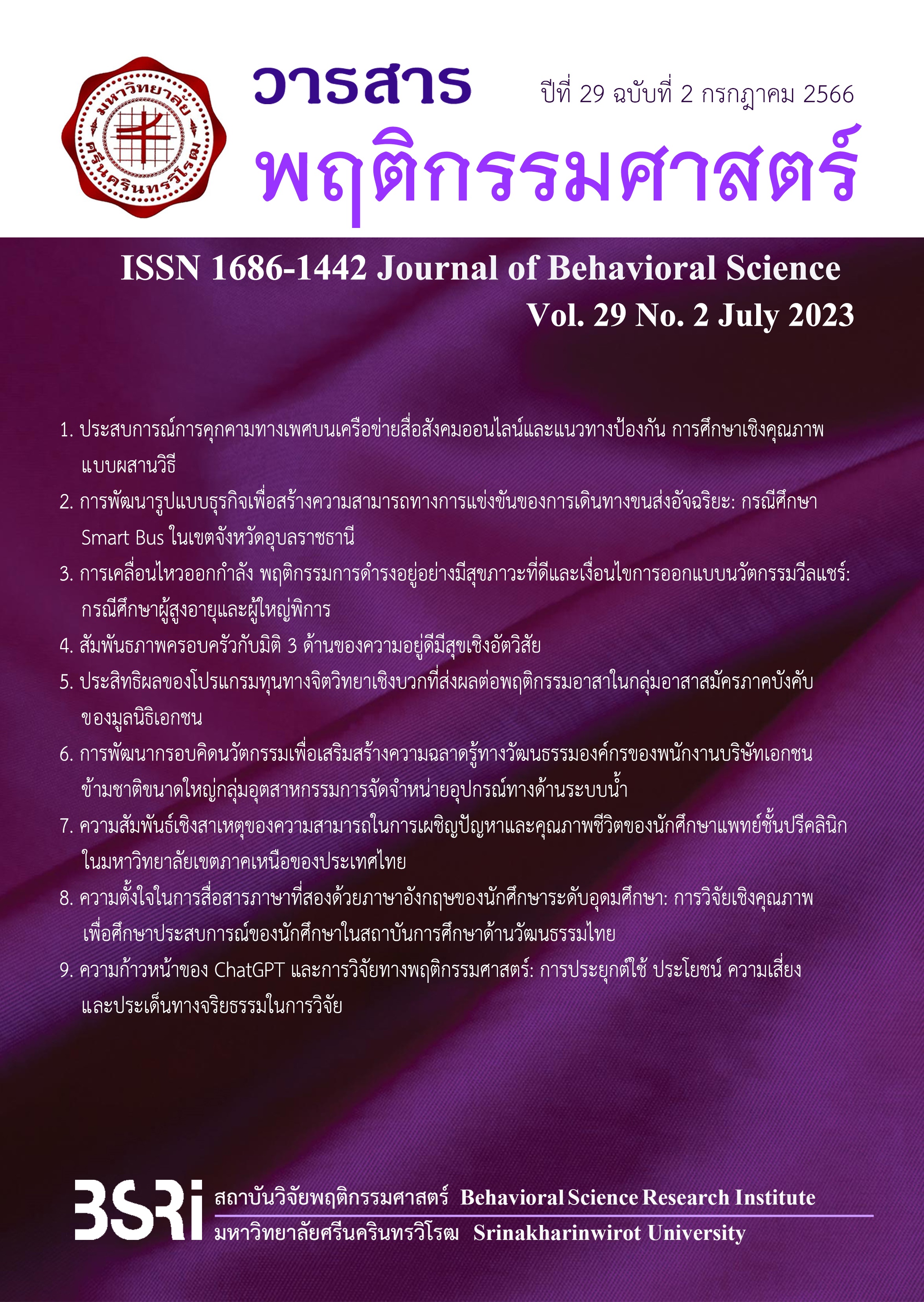Life Experience of Sexual Harassment on Online Social Media and Prevention Guideline: Qualitative Mixed Method Designs
Keywords:
Life experience, Sexual Harassment, Online social media, Qualitative mixed methodsAbstract
The qualitative mixed method designs research aims are as follows: (1) to narrate the life experience of sexual harassment on online social media from six sexual harassers experience by transcendental phenomenology based on the four steps of research process developed by Clark Moustakas. The study found that the meaning and essence of the life experience of sexual harassment on online social media are an experience that the harasser feels safe to sexual harassment. The harasser allows emotion over reasoning and reification of victims and lack of sympathy without thinking about the consequences. The harasser selection victim by know information about and the identity of victim. The victims are emotionally involved in a positive or negative relationship with their harasser, such as being intimate, offensive, irritated or angry. The harasser is self-centered and the harassment serves their own needs. The harasser lacks conscience when they harass their victim whether or not the harassment will affect the victim. The researcher used the results to answer research objectives: (2) to create prevention guidelines for sexual harassment on online social media from seven sexual harassment specialists by thematic analysis. The research results lead to presenting the sexual harassment prevention guidelines: public relations for modus operandi; enforcing the law; creating awareness of the possibility of being prosecuted; and cultivating morals and ethics.
Downloads
References
Aetsakun, S. (2017). Khwāmrū bư̄angton thāng sangkhomwitthayā [Introduction to Sociology]. Chulalongkon University Press.
Athiwet, S. (2014). Kān khukkhām thāng phēt bon sangkhom khrư̄akhāI [Sexual Harassment on Social Network]. Veridian E-Journal Silpakorn University, 7(3), 901-916. https://he02.tci-thaijo.org/index.php/Veridian-E-Journal/article/view/17887
Barak, A. (2005). Sexual Harassment on the Internet. Social Science Computer Review, 23(1),
-92. https://doi.org/10.1177/0894439304271540
Chaichukun, Y. (2016). Phrưttikam sāt mummō̜ng nai sāt thī tǣktāng [Behavioral sciences from diverse perspectives]. Behavioral science research institute, Srinakharinwirot University.
Henry, N., & Powell, A. (2016). Technology-Facilitated Sexual Violence: A Literature Review of Empirical Research. Trauma Violence Abuse, 19(2), 195-208. https://doi.org/10.1177/1524838016650189
Keecharoen, P. (2013). Kān khukkhām thāng phēt nai sangkhom Thai [Sexual Harassment in Thai Society]. Journal of Integrated Sciences, 10(1), 33-53. https://so06.tci-thaijo.org/
index.php/citujournal/article/view/246820
Manipakon, P. (2010). Atchayā witthayā læ thanthawitthayā [Criminology and Penology]. M.T.Press.
Maniphak, K. & Loettomonsakun,U. (2019). Kān tok pen yư̄a ʻātchayākam čhāk kānkratham phit nai lōk ʻinthœ̄net : kō̜ranī sưksā kān rangkǣ kan nai lōk sai bœ̄ nai rūpbǣp kān khukkhām thāng phēt nai khēt Krung Thēp Mahā Nakhō̜n [Crime Victimization on the Internet: A Case of Cyber Bullying in the Form of Sexual Offenses in the Bangkok Metropolitan Area]. Research and Development Journal Suan Sunandha Rajabhat University, 11(2). https://so05.tci-thaijo.org/index.php/irdssru/article/download/233383/
/789455
Manochai, A., Ayuwat, D., & Suthisa C. (2011). Phai khukkhām thāng phēt tō̜ wairun ying phān phư̄nthī samư̄an čhing [Threat of Sexual Harassment Against Female Adolescents in Virtual Space Interaction]. Journal of Education Khon Kaen University, 34(3-4), 133-145. https://so02.tci-thaijo.org/index.php/EDKKUJ/article/view/50236
Morse, J. (2010). Simultaneous and Sequential Qualitative Mixed Method Designs. Qualitative Inquiry, 16(6), 483-491. https://doi.org/10.1177/1077800410364741
Moustakas, C. E. (1994). Phenomenological research methods. Sage.
Nova, F. F., Rifat, M. D. R., Saha, P., Ahmed, S. I., & Guha, S. (2019). Online sexual harassment over anonymous social media in Bangladesh. Paper presented at the Proceedings of the Tenth International Conference on Information and Communication Technologies and Development - ICTDX '19. https://doi.org/10.1145/3287098.3287107
Phaowatthana, A., Uamanikun, N., & Lakampan, S. (2017). Kān pō̜ngkan phrưttikam sīang nai wairun : nǣokhit læ kānčhatkān lāi radap [Risk Behaviors Prevention in Adolescence: Concepts and Management in Multilevel Approach]. Danex Intercoporation Co.,Ltd.
Powell, A., Scott, A. J., & Henry, N. (2018). Digital harassment and abuse: Experiences of sexuality and gender minority adults. European Journal of Criminology, 17(2), 199-223. https://doi.org/10.1177/1477370818788006
Reed, E., Wong, A., & Raj, A. (2019). Cyber Sexual Harassment: A Summary of Current Measures and Implications for Future Research. Violence Against Women. https://doi.org/ 10.1177/1077801219880959
Schenk, S. (2008). Cyber-Sexual Harassment: The Development of the Cyber-Sexual Experiences Questionnaire. McNair Scholars Journal, 12(1), 81-91. https://scholarworks.gvsu.edu/
mcnair/vol12/iss1/8/
Sitthichai, R. (2017). Phrưttikam kān rangkǣ bon lōk sai bœ̄ khō̜ng wairun [Cyberbullying Behavior among Adolescents]. Chan Muang.
Sukhantawanit, A., & Surattanakawikun, P. (2019). Manut kap sangkhom [Man and society]. Kasetsart University.
Tantichuwet, C. (2017). Chēnœ̄rēchan ǣnfā : čhēnœ̄nrēchan mai nai sangkhom Thai satawat thī 21 [Generation Alpha: New Generation in 21 Century of Thai Society]. Chulalongkon University Press.
Thipprathum, C. & Siriwong, P. (2015). kān khukkhām thāng phēt klum chāi khām phēt : kānsưksā phư̄a sāng thritsadī thānrāk [Sexual Harassment in Heterosexual: Study for Grounded Theory]. Journal of Humanities and Social Sciences Valaya Alongkorn, 10(3), 105-113. https://so06.tci-thaijo.org/index.php/vrurdihsjournal/article/view/44829
Wittek, R. (2017). Rational Choice. https://www.oxfordbibliographies.com/view/document/obo-9780199756384/obo-9780199756384-0070.xml
Zimbardo, P. G. (1969). The human choice: Individuation, reason, and order versus deindividuation, impulse, and chaos. Nebraska Symposium on Motivation, 17, 237-307. https://stacks.stanford.edu/file/gk002bt7757/gk002bt7757.pdf
Downloads
Published
How to Cite
Issue
Section
License
Copyright (c) 2023 Warasan Phuettikammasat

This work is licensed under a Creative Commons Attribution-NonCommercial-NoDerivatives 4.0 International License.
Behavioral Science Research Institute, SWU
114 Sukhumvit 23, Bangkok 10110, Thailand.
Tel.02-649-5000 # 17600



